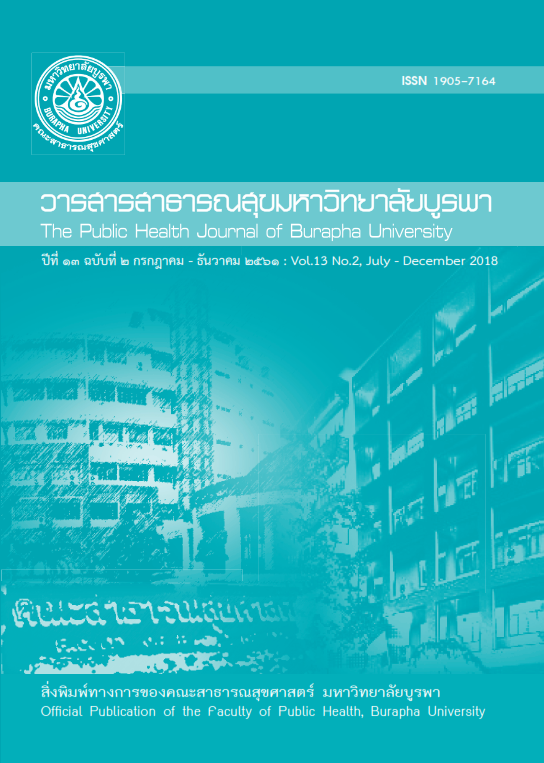ปัจจัยที่มีผลต่อการได้รับควันบุหรี่มือสองของนักศึกษาในมหาวิทยาลัยแห่งหนึ่ง
Main Article Content
บทคัดย่อ
การวิจัยครั้งนี้มีวัตถุประสงค์เพื่อศึกษาปัจจัยที่มีผลต่อพฤติกรรมหลีกเลี่ยงการได้รับควันบุหรี่มือสองของนักศึกษาในมหาวิทยาลัยแห่งหนึ่ง โดยประยุกต์ใช้ทฤษฎีแบบแผนความเชื่อด้านสุขภาพเป็นกรอบแนวคิดการวิจัย กลุ่มตัวอย่างคือ นักศึกษาชั้นปีที่ 4 ในมหาวิทยาลัยแห่งหนึ่งในเขตภาคเหนือของประเทศไทย จำนวน 351 คน ที่ได้จากการสุ่มตัวอย่างแบบหลายขั้นตอน เก็บข้อมูลโดยใช้แบบสอบถาม และวิเคราะห์ข้อมูลโดยใช้สถิติเชิงพรรณนา สถิติไคสแควร์ และสถิติวิเคราะห์การถดถอยพหุโลจิสติกส์
ผลการวิจัย พบว่า มีนักศึกษาเคยได้รับควันบุหรี่มือสองภายในมหาวิทยาลัย ร้อยละ 32.2 และสถานที่ที่ได้รับควันบุหรี่มือสองในมหาวิทยาลัยมากที่สุดคือ ห้องน้ำบนอาคารเรียน บริเวณที่จอดรถ และบริเวณทางเท้า นักศึกษาส่วนใหญ่มีพฤติกรรมหลีกเลี่ยงการได้รับควันบุหรี่มือสองอยู่ในระดับมาก ร้อยละ 59.5 โดยพบว่าตัวแปรที่มีผลต่อพฤติกรรมการหลีกเลี่ยงการได้รับควันบุหรี่มือสองอย่างมีนัยสำคัญทางสถิติที่ระดับ 0.05 ประกอบด้วย เพศหญิง (ORAdj=1.747, 95% CI: 1.056-2.890) ไม่เคยมีการสูบบุหรี่ในรอบ 6 เดือนที่ผ่านมา (ORAdj=6.554, 95% CI: 1.348-31.877) มีความรู้เรื่องพระราชบัญญัติคุ้มครองสุขภาพของผู้ไม่สูบบุหรี่ พ.ศ. 2535 ในระดับมาก (ORAdj=1.965, 95% CI: 1.112-3.473) และมีการรับรู้ประโยชน์ของการหลีกเลี่ยงการได้รับควันบุหรี่มือสองในระดับมาก (ORAdj= 1.647, 95% CI: 1.026-2.643) โดยร่วมกันทำนายพฤติกรรมหลีกเลี่ยงการได้รับควันบุหรี่มือสองของนักศึกษาในมหาวิทยาลัยได้ร้อยละ 15.2 ดังนั้น มหาวิทยาลัยควรส่งเสริมพฤติกรรมหลีกเลี่ยงควันบุหรี่มือสองโดยการเสริมสร้างความรู้เรื่องพระราชบัญญัติคุ้มครองสุขภาพของผู้ไม่สูบบุหรี่ พ.ศ. 2535 ควบคู่กับการเสริมสร้างการรับรู้ประโยชน์ของการหลีกเลี่ยงการได้รับควันบุหรี่มือสอง
Article Details
References
2. WHO Tobacco Free Initiative. International Consultation on Environmental Tobacco Smoke (ETS) and Child Health. Geneva: WHO; 1999.
3. Windham GC, Eaton A, Hopkins B. Evidence for an association between environmental tobacco smoke exposure and birthweight: a meta-analysis and new data. Paediatr Perinat Epidemiol 1999;13(1):35-57.
4. Enstrom JE, Kabat GC. Environmental tobacco smoke and tobacco related mortality in a prospective study of Californians, 1960-98. BMJ 2003; 326(7398):1057.
5. World health organization. Tobacco free initiative. WHO/Non communicable disease and mental health. World no tobacco day 2007: smoke free inside: create and enjoy 100% smoke-free environment. France: World health organization; 2007.
6. World Health Organization. WHO Framework Convention on Tobacco Control. Geneva: World Health Organization; 2003.
7. ศิริวรรณ พิทยรังสฤษฏ์, อรุณรักษ์ คูเปอร์ มีใย, สาลินี แจ่มจ้า, จินตนา ปีสิงห์, ศัญชญา ภูแล่นสูง, ประภาพรรณ เอี่ยมอนันต์ และคณะ. FCTC เพื่อสังคมไทยไร้ควันบุหรี่: เอกสารการประชุมวิชาการบุหรี่กับสุขภาพแห่งชาติ ครั้งที่ 10. ศูนย์วิจัยและจัดการความรู้เพื่อการควบคุมยาสูบ (ศจย.). กรุงเทพฯ: เจริญดีมั่นคงการพิมพ์; 2554.
8. ศูนย์วิจัยและจัดการความรู้เพื่อการควบคุมยาสูบ. (2554). สรุปสถานการณ์การบริโภคยาสูบรายจังหวัด พ.ศ.2554. กรุงเทพฯ: เจริญดีมั่นคงการพิมพ์; 2554.
9. ศรัณญา เบญจกุล, มณฑา เก่งการพาณิช และณัฐพล เทศขยัน. (2554). คู่มือข้อถามยาสูบและตัวชี้วัดมาตรฐานสำหรับการควบคุมยาสูบตามยุทธศาสตร์ MPOWER. สำนักควบคุมการบริโภคยาสูบ. นนทบุรี: ไนซ์ เอิร์ธ ดีไซน์; 2554.
10. พัชมณ ใจสะอาด และเบญจวรรณ ธรรมรัตน์. มาตรการกฎหมายในการควบคุมการสูบบุหรี่ในสถานศึกษา. วารสารจันทรเกษมสาร, 2557; 20(39): 11-18.
11. Wang WL, Herting JR, & Tung YY. Adolescents' avoidance of secondhand smoke exposure: Model testing. Western Journal of Nursing Research, 2008; 30(7), 836−851.
12. Thrasher JF, Boado M, Sebrie EM, & Bianco E. Smoke-free policies and the social acceptability of smoking in Uruguay and Mexico: Findings from the International Tobacco Control Policy Evaluation Project. Nicotine & Tobacco Research, 2009; 11(6):591−99.
13. Willemsen MC, & De Vries H. Saying “no” to environmental tobacco smoke: Determinants of assertiveness among nonsmoking employees. Preventive Medicine, 1996; 25(5), 575−582.
14. รุ่งราวี ทองกันยา และ สุนิดา ปรีชาวงษ์. ปัจจัยทำนายพฤติกรรมการหลีกเลี่ยงการ ได้รับควันบุหรี่มือสองของผู้ป่วยโรคเรื้อรังในกรุงเทพมหานคร. วารสารพยาบาลทหารบก, 2557: 15(2):331-38.
15. สนอง คล้ำฉิม. ความสัมพันธ์ระหว่างการรับรู้อันตรายจากควันบุหรี่มือสองกับพฤติกรรมสุขภาพของสมาชิกครอบครัวที่มีผู้สูบบุหรี่ (การศึกษาค้นคว้าด้วยตัวเอง หลักสูตรวิทยาศาสตรมหาบัณฑิต) มหาวิทยาลัยศิลปากร; 2551.
16. เพ็ญนภา บุญแก้ววรรณ. การหลีกเลี่ยงควันบุหรี่ในหญิงตั้งครรภ์ (วิทยานิพนธ์พยาบาลศาสตรมหาบัณฑิต สาขาการพยาบาลอนามัยชุมชน) มหาวิทยาลัยมหิดล; 2550.
17. อนุศฎา นุราภักดิ์ และคณะ. ปัจจัยที่มีความสัมพันธ์กับพฤติกรรมการปกป้องสิทธิของตนเองจากควันบุหรี่มือสองของนักเรียนชั้นมัธยมศึกษาตอนต้นในกรุงเทพมหานคร. วารสารวิทยาลัยพยาบาลบรมราชชนนี, 2557; 30(2), 37-47.
18. Comrey AL, Lee HB. A first course in factor analysis (2nded.). Hillsdale: Lawrence Erlbaum Associates; 1992.
19. Polit D, Beck C. The content validity index: Are you sure you know what’s being reported?. Research in Nursing & Health 2006;29:489-97.
20. George D, Mallery P. SPSS for windows step by step: A simple guied& reference 11.0 update (4th ed.) Boston: Allyn & Bacon; 2003.
21. Becker MH, & Maiman LA. The health Belief Model: Origins and Correlation in Psychological Theory. Health Education Monography, 1975; 2: 336-385.
22. Glanz K, Rimer BK, and Viswanath K. Health behavior and health education: theory, research, and practice. San Francisco, CA, Jossey-Bass; 2008.
23. Watkins CM, Sandeep M, Kaur Thind H, Gokarakonda SB, Lartey G and Chahal M. Second-Hand Smoke in a University Campus: Attitudes and Perceptions of Faculty, Staff and Students. International Journal of Health Research, 2011; 4(1), 21-27.
24. Skinner CS, Tiro J & Champion VL. The Health Belief Model. In Health behavior: Theory, research, and practice (5th ed). San Francisco, CA, US: Jossey-Bass; 2015.
25. Li MF and Wang RH. Factors related to avoidance of environmental tobacco smoke among adolescents in southern Taiwan. J Nurs Res, 2006; 14(2), 103-12.
26. Schwartz et al.: An examination of exposure and avoidance behavior related to second-hand cigarette smoke among adolescent girls in Canada. BMC Public Health, 2014: 14:468
27. Maziak W, Ward KD, Eissenberg T. Measuring exposure to environmental tobacco smoke (ETS): a developing country’s perspective. Prev Med. 2006;42(6):409–414.
28. Champion V, Skinner CS. The Health Belief Model. In: Glanz K, Rimer B, Viswanath K, editors. Health behavior and health education. 4. San Francisco, CA: Jossey-Bass; 2008. pp. 45–65.
